|
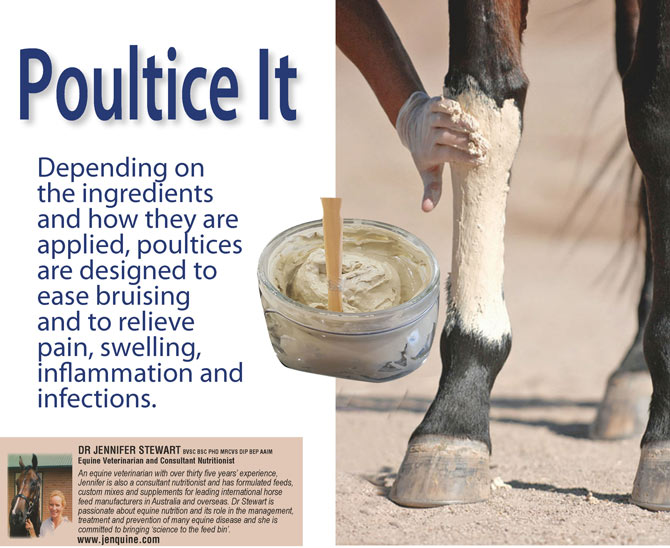
Compresses, concoctions, pads, plasters, poultices, potions, wrappings and wads. Comprised of a combination of clays, herbs, salts, essential oils, medications and minerals, generations of humans and animals have found relief from mixtures that have been applied as poultices to the body’s surface.
Meaning ‘porridge’ in latin, poultices are uniformly moist and soft; can be icy cold through to warm and hottish; are usually based on clay, cereals and plant materials, and may contain astringents, emollients and antibiotics. They can be commercial or home-made and – depending on your horse’s needs - the exact action of the poultice can be changed with the temperature, application method and ingredients.
Before using any poultice look at the ingredients. Although mud alone can act as a poultice, there are cleaner and more effective options – some commercial and some home-made. Among the options for a home-made poultice are baking soda, bran, comfrey root, chamomile, Epsom salts, iodine, kaolin, kaopectate, oatmeal, peppermint leaves and sugar. See Table 1.
COLD THERAPY
Generally, cold poultices are best for acute injuries, bites, stings and after exercise. Used to reduce pain, minimise swelling and decrease inflammation, they are a form of ‘cold therapy’. Although cold-hosing and ice are more effective for cooling, they are not always available and a clay-based, cooling poultice is an alternative option for drawing heat from legs after work. As the clay begins to dry, it draws fluid from the tissues underneath and as the poultice water evaporates, it takes the heat with it. This is similar to icing an injured area, but a poultice can provide hours of therapy. The heat from your horse’s leg will gradually warm up the poultice, and if a bandage is placed over the poultice it can cause the area to heat up even more. To reduce this, a damp cloth or moistened brown paper can be placed between the two to keep the poultice and the area moist and cool for longer.
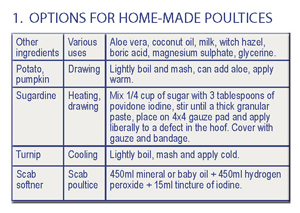
Because cold therapy poultices help to reduce pain and minimise swelling, a widespread practice in many disciplines, including eventing, show-jumping and race training, is to use them as a preventative therapy for muscles, tendons, ligaments and joints both before and after exercise. When competing, horses work harder, travel further and are confined more often so they experience more musculo-skeletal stress and this predisposes them to injury.
To enable horses to recover and recuperate well, poulticing is often a routine daily practice.
Usually based on clay or salt, the poultice material is cooled in the fridge and then spread thickly on the cannon bones, tendons and ligaments of the legs – and more is better!
After hard work the poultice is applied to all four legs and covered with a damp cloth or paper. The temporary cooling and natural astringent properties help minimise swelling, soreness, stiffness, inflammation and support faster recovery.
This management method is also known as ‘sweat-wrapping’. Sweat bandages help reduce fluid build-up in the legs of horses suffering from strains or other injuries and confined to a stall for recuperation. The American Association of Equine Practitioners recommends applying a poultice to the legs, then covering the legs with light plastic wrap or cellophane and cotton bandaging.The sweat bandage reduces inflammation and helps remove excess fluid from the leg, but it is totally unsuitable for open wounds.
HEATING OR COOLING
Some horses do best after daily workouts with a short-term cool poultice. Others seem to respond best to a heat-inducing poultice. If there is localised swelling, or just one leg affected, it can be cold-poulticed while awaiting veterinary attendance.
For certain injuries, your veterinarian may recommend a cool poultice for the first few days and then a warm one a couple of days later. Alternating cool and warm poultices works well for many horses.
Lacerations of the limb are common in many sports where horses jump over fixed fences and varied terrain. Over-reach wounds of the heel and stud-related punctures are quite common and can be quite painful to the horse. With water jumps, these wounds are often contaminated, require antibiotic therapy and tetanus prophylaxis if needed. First aid while awaiting veterinary treatment includes application of a drawing poultice.
COOLING
A cooling poultice will also go a long way to making your horse more comfortable after an insect bite or sting. Put a thin layer of the poultice on each welt, covering it completely. There’s no need to bandage and by reducing the irritation of the bite there’s less likelihood they’ll rub on fences or stall walls – getting splinters and possibly infected.
WARMING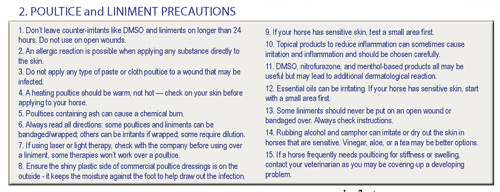
Warm poultices are used for applying heat to increase blood flow to the area - an important part of healing and great for older injuries and abscesses. Surface heat can penetrate about 2cm - decreasing blood pressure, superficial muscle spasm and pain, while increasing blood flow, cell metabolism, muscle relaxation and tissue elasticity.
HEATING
When there is pain, joint stiffness and reduced range of motion your veterinarian may recommend heat therapy for 15-30 minutes, 2-3 times a day – usually starting within 24-72 hours after injury. Heat is contraindicated when there is acute inflammation, bleeding or fever, so always check with your veterinarian first. And, the poultice should be warm, not hot - test it on your own skin before applying it to your horse.
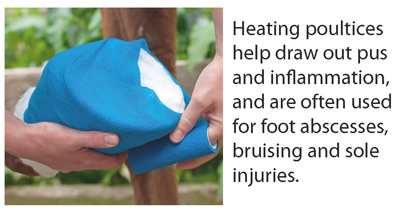
While it may be long-awaited, it’s nearly always fantastic to have some rain – but it does increase the incidence of foot abscesses, so take time to check your horse’s feet. After prolonged periods of dryness/drought, hooves soak up water very quickly and any wall cracks can quickly become packed with mud and bacteria. From here, these gain entry to the sensitive structures of the hoof – underneath which lies the coffin or pedal bone. Within days an abscess can form – producing bounding digital pulses, heat along the coronary band, pain, swelling of the pastern and fetlock and acute lameness. To help prevent an abscess, keep hooves clean and spray or paint the sole daily with a 50:50 mixture of methylated spirits and strong iodine.
If an abscess is suspected, poulticing the hoof can help soften the sole and draw out the pus.
Use a warm poultice (Epsom salts or sugardine), apply and wrap in place. (Table 3.) Change the poultice after eight hours. If the abscess doesn’t burst, your veterinarian may apply an overnight poultice to soften the hard epidermal tissues and encourage drainage.
These often consist of a 5 litre bag containing a ‘porridge’ of bran, warm water, betadine solution, Epsom salts and DMSO. Once drainage is established you need to continue poulticing the foot for several days. If the discharge persists or abscesses recur, Xrays may be required to rule out pedal bone infection or osteomyelitis. Always consult your vet if your horse suddenly becomes lame, the major symptom of an abscess brewing. It’s also a good time to check your horse’s tetanus vaccination is up to date! Always talk to your veterinarian if you suspect a hoof issue or abscess - it might be simple and uncomplicated, or more serious than it appears. If your horse is lame (either mild or 3-legged) it may have an abscess - so don’t hesitate to give your equine vets a call.
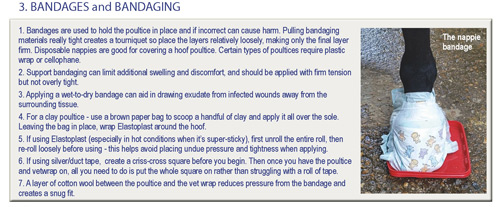
Old injuries may respond to a version of the setting-up system. In those cases, you definitely want warmth on the area. To prolong the heating effect of a liniment, you can wrap cellophane over the area before putting on your cotton wrap. This will help to “trap” the heat and provide warmth for a longer period of time. Always be sure your liniment is safe to use in this way and won’t blister the leg.
Sole bruising may occur acutely (stepped on a stone, concussion etc.) resulting in lameness from the bruising which may or may not develop into an abscess. Either way, if your horse is lame in the foot, initiate treatment before the vet arrives, with a poultice to help draw out bruising - and an abscess if one forms. All that lies between the ground and the coffin bone is the sole. Because of the proximity of the coffin bone to the sole, there is the ever-present risk of subsolar abscesses becoming osteomyelitis. Don’t delay a vet examination if the poulticing isn’t reducing the pain or the lameness is severe. If the abscess isn’t likely to erupt by itself, your vet may have to create a drainage tract to allow fluid and pus to seep away from the abscess. Once that has been done, you can poultice the foot as part of the treatment process.
POULTICES AND WOUNDS
Poultices can also be applied to wounds. ‘Wound’ is a broad term and includes anything from minor scratches to degloving injuries. But of most significance is the anatomical location. A small, inconspicuous puncture wound or laceration over a joint or tendon sheath can be far more sinister than the most shocking wound on a fleshy area. Get your vet involved sooner rather than later as early intervention can save you time, money and protect you horse’s well-being. The advances in wound management, dressings, bandages and treatments for horses is different to humans and evolving at a rapid rate.
LINIMENTS
A similar, useful inclusion to the first-aid kit is liniments. Liniments are liquids or gels, with similar properties to poultices in that they are applied to the body to help with cooling, heating, pain, stiffness or soreness. Composed of plant extracts, essential oils and other compounds, they are usually based on vinegar, rubbing alcohol, aloe vera or witch hazel. The exact heating or cooling effect depends on what the ingredients are and how they’re applied. The massaging and rubbing-in can also be soothing and improve circulation. Due to the more liquid consistency, they are especially suited to the back and particularly useful for cooling after hard work. For the back, poultices can be made from plant material steeped in hot water and applied to the body. If you apply a poultice to your horse’s back, wash the back well before riding as leftover ingredients can be pretty rough under a saddle.
Warming liniments are also useful after a hard workout to help relax the muscles and improve the circulation. Cooling liniments are indicated after damage and fresh inflammation, usually within the first few days to a week after an injury. If a hard work session generated inflammation or activated some injured areas, or if the weather is very hot, cooling liniments can be beneficial. The theory behind the formulations are that the alcohol component will evaporate quickly, taking some heat with it. Many oil components then stimulate dilation of the capillaries, which will also hasten cooling off. When applying them your hands may identify any sore or swollen areas. Catching problems early almost always means faster resolution.
Some liniments contain oils that will ‘heat up’ or ‘cool down’ an area. Common ingredients include menthol, mints, eucalyptus, and capsaicin (from chilli peppers). Most of these warm up the area and applying warmth is especially helpful for older horses where a massage and rubdown before and after a workout can really increase comfort.
If you keep poultice materials handy then it is a question of ‘when’ not ‘if’ you will use them. When your horse develops a wound or injury there are many bandages, liniments, opinions, poultices, salves and treatments available that are at best confusing and at worst contradictory. Living as we do in the digital age, we turn to the huge amount of information on the internet – some of which can be relied upon, some of which can be harmful to your horse. Because the accuracy of the information is important, and cannot always be verified on the Internet it is safer to chat to your vet first.
DISCLAIMER
All content provided in this editorial is for general use and information only and does not constitute advice or a veterinary opinion. It is not intended as specific medical advice or opinion and should not be relied on in place of consultation with your equine veterinarian.

OTHER TOPICS available online by Dr Jennifer Stewart
Vol 41 - 2
LYME DISEASE IN AUSTRALIA
Vol 41 - 1
I CAN HEAR SAND
Vol 40 - 6
LAMENESS
Vol 40 - 4
STRESS - how do we know if our horse is stressed?
Vol 30 - 1
STIFLE LOCK
with the Equine Veterinarians Australia (EVA)
Vol 27 - 4
ROSS RIVER VIRUS
Vol 36 - 6
BIOSECURITY
Vol 31 - 5
BIG HEAD
Vol 35-6
WHAT CONTROLS APPETITE IN HORSES?
Vol 35 - 4
BEHAVIOUR OR PMS
|